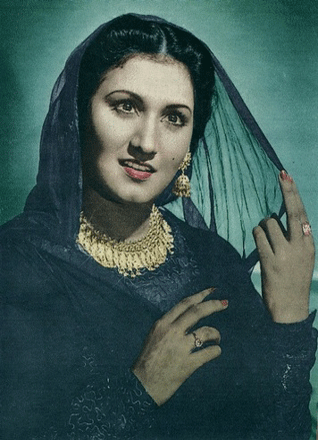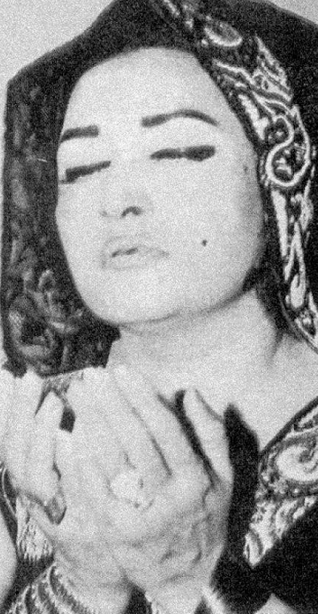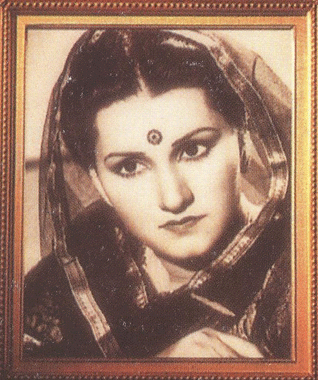Music
Noor Jehan: Punjab's Queen of Melody
by SADIA MALIK
Noor Jehan, the melodious voice that touched millions in Punjab and across the subcontinent - the undisputed Mallika-e-Tarrannum (Queen of Melody) who sang thousands of songs over six decades in both Punjabi and Urdu - made her one of the most popular singers of the 20th century and an epic cultural figure.
Besides enthralling music lovers with countless ghazals and film songs, she inspired Punjabis on both sides of the Indo-Pakistan border. Her name literally means, "Light of the World" and indeed, the shine of her star shall light up the world forever.
Her Life and ArtHer career spanned seven decades of unparalleled, unchallenged reign. In time, the child star Baby Noor Jehan became Madam Noor Jehan, then the Melody Queen. Artists across the sub-continent have been inspired and overawed by her.
Indian singer, Lata Mangeshkar, a legend in her recording time, refers to her with veneration. Who else could be Pakistan's personality of the millennium but Noor Jehan? The exact point in time when the title of Melody Queen was bestowed on her cannot be fixed. She was coronated by popular acclaim by admirers, connoisseurs, experts and critics of music and has ever since ruled the realm of music here with the consent of the masses and classes who have any interest in music.
While she got her start from Calcutta, it was in Lahore, close to her hometown Qasur where the limelight flooded her. Master Ghulam Haider, a master in the truest sense of the expression put the raw gold in the child's voice in Gul Bakawli (1939) with "Shala jawanian mane..." on the road to lasting fame.
In another movie, the same composer's "Bas bas wey dholna" accorded her instant mass popularity. From then on there was no looking back for the precocious child who was just ten at the time. But maturity and professional recognition came with her first film as leading lady, at the age of 14 in Khandan (1942) with "Tu konsi badli mein mere chand hai aaja..." Once again, the composer was Ghulam Haider.
Khandan was directed by Syed Shaukat Hussain Rizvi, a handsome young film editor from Calcutta who had been inducted as director by necessity. The movie led to a tumultuous real-life affair, elopement, marriage, to a saga of romance at times bordering on madness, plunging often into sadness, then despair, finally snapped ties and a scandal-filled relationship marked by the deepest and the most expressive of ambivalence - mostly hate. The two spent years running each other down only to underline that they could not get over their first love. However, much before Rizvi's death, the news of his demise was not conveyed to her as she lay ailing in the U.S. for fear that it would disturb her.
They had accepted each other's presence and made peace with each other. In a period when singer-actresses ruled the silver screen, Noor Jehan was amply endowed with both exceptional beauty and an extraordinary voice.
Vivacious, young, then only 14, wide-eyed Saadat Hasan Manto described her facial features as exuding excitement, seductiveness and vitality. She was a young beauty whose looks scored with both film-makers and cine-goers and was cast as leading lady even though her short stature caused a few production problems.
Teamed with Pran, bricks were used in many scenes to raise her to the required physical height. As an artist, whether as singer or actress, she never needed help. Almost from day one, she had a position all her own. Marriage to Rizvi took her to Broadway, to new and vaster horizons. Director Mehboob cast her in Anmol Gharrhi (1946) in which she had a chance to work with one of the greatest composers of India, Naushad. Rizvi paired her with a young and promising but little known actor, Dilip Kumar in Jugnoo (1947).
Both films were big hits at the box office. The teenaged singer-actress had taken Bollywood by storm; she was heralded as a star of dazzling luminosity. She was poised for sweeping the Indian cinema, both as actress and singer at that time.
But in newly created Pakistan, too, her career continued flourishing though the industry was in its infancy, much smaller in size and resources in comparison with Bombay and operated in a restricted circuit. Professional standards were not of a quality to do justice with her immense potential. Despite such handicaps, she went from proverbial success to success, from glory to glory.
A somewhat questionable achievement was becoming that first woman director of films in Pakistan. That was with Chan We (1951), produced by Rizvi. But marriage hit the rocks and floundered after ten years and three children. Another marriage with actor Ejaz ended in a similar way after three more children. There were ups and downs in her personal life.
But her career prospered. The magnificence of her voice groomed in her early years by Kajjan Bai, a famous Indian singer of the 20s and 30s, and enriched by riyaz lasting up to twelve hours or more every day, gave her heights while as an actress she gathered lustre with every film. She gave significant performances in Dopatta (1952), Gulnar (1953), Intezaar (1956), Lakht-e-Jiggar (1956), Anaarkali (1958), Koel (1959) and Neend (1959), to name a few of her movies of the 50´s.
She had indeed become eligible for playing lead only as an actress. It is, however, unlikely that her acting could ever match the excellence of her singing. In any case, marriage with Ejaz put a stop to her career as an actress. He did not want her on the screen and she acquiesced like a conventional housewife. She herself wasn't much interested in acting.
The decision provided a boost for her singing. With acting out of the way, she could concentrate on singing with singlemindedness. As playback singer, she touched new heights with Mousqaar (1962), Sawaal (1966), Lakhon mein aik (1967), Mirza Jutt (1967), Dosti (1971), Naag Munni (1972), Heer Ranjha (1970), Sher Khan, Sala Sahib & Chan Waryam (1981), Sholey (1984), Moula Bakhsh (1988) and innumerable other movies.
Indeed after the break with Ejaz, she plunged headlong into playback singing, often recording five to six songs in a day. How many songs she recorded in her career is anybody's guess. Estimates place the number above ten thousand. It is a sad commentary on the state of management of arts in Pakistan that an undetermined percentage of her work may have perished. There is no inventory even of songs she recorded; a library of Noor Jehan's songs is a far cry. It is time the Ministry of Culture, along with serious-minded people from the film industry (there still are a few professionally-oriented men in cinema) got down to putting things in order and at least preserving what has survived the ravages of neglect.
While she has been acclaimed as the supreme soprano, a truly gifted artist and adulated, her class and contribution have never been critically evaluated. What exactly is the place of Madam Noor Jehan in the music of, first, the subcontinent, and then Pakistan? "Unrivalled, incomparable," says Nisar Bazmi, virtually the last of authentic composers of Pakistan's cinema.
Most of the master composers whose work she brilliantly rendered are no longer alive or are across the border. Master Ghulam Haider, Feroz Nizami, Rashid Attre, Khurshid Anwar, G. A. Chishti, Master Anayet Hussain, Master Abdullah, A. Hameed, Naashad, Kamal Ahmad, are all part of our cultural history, albeit a neglected one.
Naushad, one of the first composers for whom she sang in Bombay is in India. Only Nisar Bazmi is around. For him, she is a "gift" from nature, an artist with no peer. He says: "The throw of words by her remains unmatched. She was the first singer to bring expression to film music. She could render love songs, compositions depicting joy, sadness, tragedy with facility of movement."
Veteran recording engineer Sayed Afzal Hussain who teamed with Khurshid Anwar for many films, emphasizes expression from another angle. Her rendering always matched the expression of the artist and her voice had "intangibility, resonance, depth and strength," he says. Afzal Hussain recalls many songs to exemplify this point. One of them is a lori, "Raaj dulare meri akhiyoon ke tare tere ware ware jaoon..." she sang in Lakht-e-Jigar (1956). According to him, there has been "no lori like this in the music of the subcontinent."
Ahmed Rahi, who penned the poetry for many a song by the Melody Queen, among them the immortal lyrics of Heer Ranjha (1970) and Mirza Jutt (1967), marvels at her comprehension of words. He found in her a "capacity to decipher good verse from versified lines."
He recalls an incident from Jadoo (1974). "A verse was considered too heavy by the producer and he wanted it replaced. Sure of his ground, Rahi disagreed, arguing that the people for whom he wrote would know why he had written it. When Noor Jehan came to the verse while recording the song, she looked in my direction and waved to acknowledge the quality," he says.
Qateel Shifai also has a word of praise for her rendering of poetry. "She sang with understanding; her delivery was remarkably fluent," he says.
While she remained confined to light music and popular singing, she always believed in classical music. "Pop" she said, "is like a foundation of sand; a cooking pan of wood. The same songs reappear after some time. Classical is eternal". A strong classical base is reflected in her singing. She effortlessly moved in difficult, demanding trajectories. High and low notes came to her naturally to underline and elaborate the range of her talent. The fibre of her voice retained resolution in all scales. Her articulation of turns, enunciation of emphasis, pauses and stresses belong to the most creative dimension of virtuosity.
Madam Noor Jehan has been a controversial figure in many ways, often marked by contradictions that made her a target for slings and arrows from critics. But great artists are not to be measured by a yardstick. She has also been criticized for a certain harshness in behaviour at times and of greed, too. But she couldn't have survived in the cutthroat world of showbiz without toughness - she could be emotionally blackmailed though. Weakness is exploited more ruthlessly in showbiz than any other area of life. And the reputation for being a hard bargainer is more than offset by her contribution to the 1965 war.
It demonstrated that if her heart was set on something, she could sing a song for a song. She endeared herself to the people of Pakistan with her unrelenting, emotionally charged support for the war effort, motivating troops and the rest of the populace. She had legendary status in her field even before that. Her war songs, rendered with inspiring conviction, stirred the people like nothing else and made her a very special person.
The government acknowledged her work by awarding the "Pride of Performance Award" to her, making Noor Jehan the first woman to be so honoured. She used to be at the Lahore Radio Station every day, rehearsing for hours and recording a song only when she was fully satisfied. This was the patriotic involvement and commitment of a songstress who normally had one look at the score and delivered every note, every syllable in perfect order virtually off the cuff. Financial considerations never featured in that campaign.
Age and illness took hold of her for several years and she withdrew from public life; her place in the hearts of the people remained intact. When the news that she was seriously ill broke, newspaper offices were inundated with calls from her admirers; it became clear once again that she was widely adulated.
PTV's former General Manager Marketing, Khalid Ghias, a film buff and a devoted Noor Jehan fan said: "She is an honest lady, a grand one. For us, she is immortal, eternal".
That just about sums up the kind of sentiments and regard many people have for her art and her person. Her major films include pre-partition movies being Pind Di Kuri/Sheela (Punjabi), Missar Ka Sitara, Mr & Mrs Bombay, Naari Raaj, Fakhr-e-Islam, Heer Sayal (Punjabi), Mr 420, Taran Haar, Na Mumkin, Sassi Punnoo (Punjabi), Imperial Mail, Gul Bakawali (Punjabi), Yamla Jutt (Punjabi), Chaudhri (Punjabi), Khandan, Duhaai, Naukar, Nadan, Dost, Lal Haveli, Badi Maa, Bhaijaan, Gaon Ki Gori (Village Girl), Zeenat, Dil, Anmol Ghadi, Humjoli, Jugnu and Mirza Sahiban while her post-partition flicks were Chanwey (Punjabi), Dupatta, Gulnar, Patey Khan (Punjabi), Lakht-e-Jigar, Intezar, Nooran (Punjabi), Chhoomantar (Punjabi), Anaarkali, Pardesan (Punjabi), Neend, Koyal and Ghalib.
[Courtesy: The Daily Mail]
July 8, 2010
Conversation about this article
1: Irvinder Singh Babra (Brampton, Ontario, Canada), July 08, 2010, 5:15 PM.
Noor Jehan remains the Punjabi singer par excellence. Beyond her singing, her personal aura, life style, diamonds, sarees, especially the black ones, the men in her life, her mastery of words, the right punctuation and throw, and the sense of timing and situation made her a legend.






